Tourism and Non-Governmental Activities
Commercial tourism using both ships and aircraft has increased steadily since the first commercial expeditions in the late 1950s. Before the 1980s, only a few hundred tourists visited Antarctica every summer. The total number of tourists visiting Antarctica in the 2019/20 season was around 74 000. The vast majority of these visitors travel on passenger vessels to the Antarctic Peninsula region, which can be reached from South American ports in a few days. Regular sightseeing passenger flights began in 1977 using passenger aircraft flying from Australia and developed over time.
The main ATCM regulations and guidelines for tourists and expedition organizers are compiled in the Manual of Regulations and Guidelines Relevant to Tourism and Non-Governmental Activities in the Antarctic Treaty area, adopted by ATCM XLIII through Decision 6 (2021).
This compilation also includes the provisions applicable to tourism arising from the Antarctic Treaty and the Protocol on Environmental Protection. Aside from establishing guidelines for tourist expeditions, the ATCM also provides for tourist expeditions to submit reports on their visits. Measure 4 (2004), which sets out requirements on contingency planning, insurance and other matters, is currently being approved by the Consultative Parties.
The ATCM also issues specific guidelines for the sites most visited by tourists. They include practical guidance for tour operators and guides on how they should conduct visits in those sites, considering their environmental values.
Most tourist operators active in the Antarctic belong to the International Association of Antarctica Tour Operators (IAATO), which also participates in the ATCM as an invited expert organisation.
In 2021, through Resolution 3 (2011), the ATCM updated the General Guidelines for Visitors to the Antarctic, which provide general advice for visiting any location, with the objective of ensuring visits do not have adverse impacts on the Antarctic environment, or on its scientific and aesthetic values.
Parties implement the Antarctic Treaty and its Environment Protocol into domestic law. National legislations establish a permitting regime for activities in Antarctica, and eligible visitors are required to obtain the necessary permits in advance from the relevant Competent Authority of each Antarctic Treaty Party.
- Yachting guidelines for Antarctic cruises (Adopted by Resolution 10 (2012)
- General Guidelines for Visitors to the Antarctic
- Site Guidelines for Visitors Checklist
- Manual for tourism activities (ready to print version 2023)

Information
- ATCM Measures on Tourism
Related Sites

Environmentalists demand regulations for Antarctic tourism
by Heiner Kubny | May 22, 2024 | Antarctic , Antarctic , Archive , Politics , Tourism | 0 comments
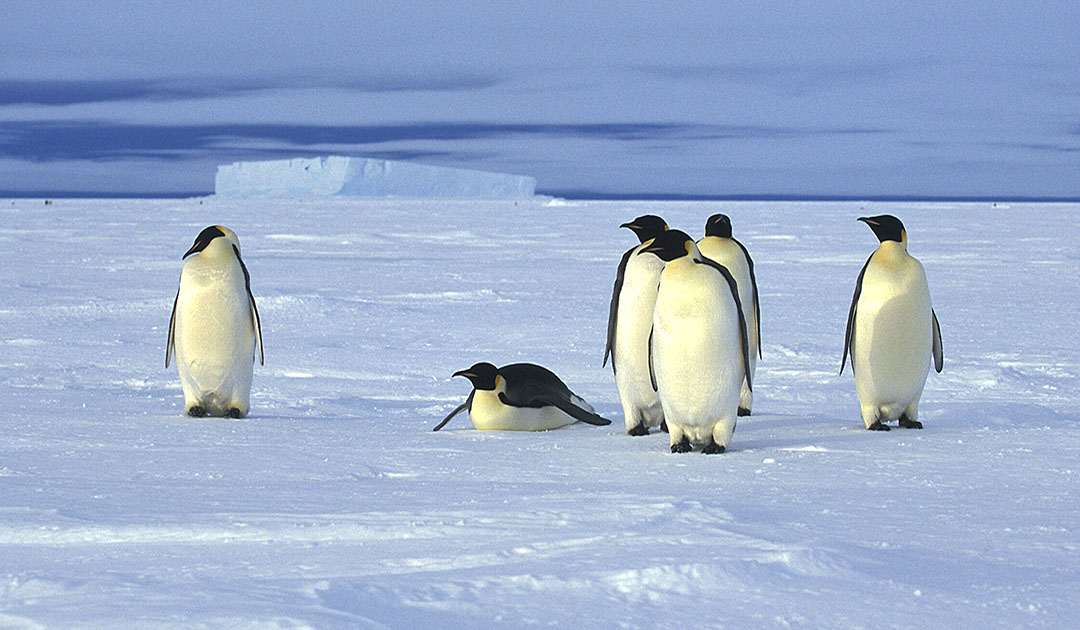
In view of an increase in tourism in the Antarctic region, which is severely affected by climate change, environmental protection organizations are calling for countermeasures. The call is addressed to the participants of the Antarctic Treaty Consultative Parties (ATCM) at the start of the meeting last Monday in Kochi, India, which will last until Thursday, May 30, 2024. Previous international efforts to improve the regulation of Antarctic tourism have largely failed.
The National Centre for Polar and Ocean Research (NCPOR) in Goa, under the Ministry of Earth Sciences, and the Antarctic Treaty Secretariat organized the meeting, which was attended by over 350 participants from almost 40 nations.
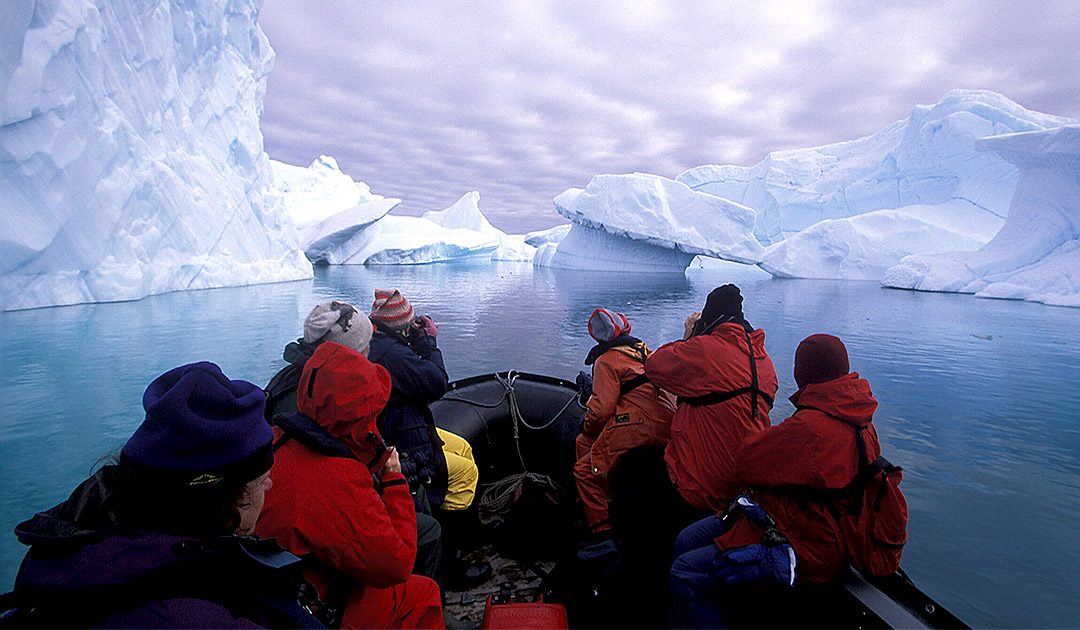
According to the International Union for Conservation of Nature (IUCN), Antarctic tourism has increased significantly since the early 1990s. Between 1992 and 2020, the number of arriving guests increased tenfold to 75,000. In the years 2022 to 2023, there were even just under 105,000 tourists.
Claire Christian , head of the Antarctic and Southern Ocean Coalition ASOC , the only non-governmental organization allowed to attend the meeting, says: “ Formal regulation of tourism has been delayed for too long. However, the upcoming ATCM offers a crucial opportunity to finally adopt enforceable regulations and prevent impacts on Antarctica’s biodiversity .”
More tourists and research stations also mean more microplastics and wastewater entering the waters, the ASOC complains. In general, the bad news about the state of Antarctica continues unabated. Sea ice is melting rapidly in the region, fish stocks are massively overexploited, and avian influenza was recently detected there for the first time.

The Antarctic Conference in India is attended by those states that have signed and ratified the Antarctic Treaty (ATCM). Among other things, it provides for the peaceful use of the continent and a ban on military activities. For years now, the Parties have also been discussing stricter control of human activities at the meetings, particularly in the area of tourism. This year’s 46th edition of the meeting now focuses on this demand.
Heiner Kubny, PolarJournal

Submit a Comment Cancel reply
Your email address will not be published. Required fields are marked *
Save my name, email, and website in this browser for the next time I comment.
POLARJOURNAL GOES APP!!

ADVERTISEMENT

Hier könnte ihre Werbung stehen
Neue beiträge.
- Could seaweed be Greenland’s next big export?
- Mirny’s chief mechanic missing in storm
- Suspicious buoy discovered in the Chukchi Sea
- In the shadow of bubbling lava – the presidential election in Iceland
- Permafrost could release more greenhouse gases than previously assumed
- Skip to main content
- Keyboard shortcuts for audio player

Environment Story Of The Day NPR hide caption
Environment
- LISTEN & FOLLOW
Your support helps make our show possible and unlocks access to our sponsor-free feed.
Antarctica cruises are more popular than ever. Experts say they need more regulations
Cruises to Antarctica, already popular, have grown dramatically in recent years. Scientists and advocacy groups say tighter regulation is needed to minimize the impact on wildlife and the environment.
Copyright © 2023 NPR. All rights reserved. Visit our website terms of use and permissions pages at www.npr.org for further information.
NPR transcripts are created on a rush deadline by an NPR contractor. This text may not be in its final form and may be updated or revised in the future. Accuracy and availability may vary. The authoritative record of NPR’s programming is the audio record.
Regulating Tourism in the Antarctic: Issues of Environment and Jurisdiction
Cite this chapter.

- Mike G. Richardson
Part of the book series: Environment & Policy ((ENPO,volume 28))
160 Accesses
5 Citations
During the early 1990s, debate on the adequacy of the regulation of tourism in Antarctica provided one of the more vigorous exchanges between Antarctic Treaty parties. Coming so soon after the adoption of the Environmental Protocol, 1 the debate may have fuelled doubts amongst some commentators as to whether the environmental protection regime foreseen by the Protocol was indeed as comprehensive as Treaty parties had intended. The debate came at a sensitive time. In the late 1980s and early 1990s, just when the Antarctic Treaty 2 was attempting to enhance its environmental credentials to a wider audience, including the United Nations, tourism, seemingly unregulated, was escalating at a considerable rate. With the increase in tourism came the concern that potential impacts might not only affect the Antarctic environment but also have adverse implications for other legitimate activities, notably scientific research and its associated logistics.
Article FootNote
1 ILM, Vol. 30, 1991, pp. 1,461ff.
2 UNTS, Vol. 402, pp. 71ff.
This is a preview of subscription content, log in via an institution to check access.
Access this chapter
- Available as PDF
- Read on any device
- Instant download
- Own it forever
- Available as EPUB and PDF
- Compact, lightweight edition
- Dispatched in 3 to 5 business days
- Free shipping worldwide - see info
- Durable hardcover edition
Tax calculation will be finalised at checkout
Purchases are for personal use only
Institutional subscriptions
Unable to display preview. Download preview PDF.
You can also search for this author in PubMed Google Scholar
Editor information
Editors and affiliations.
The Fridtjof Nansen Institute, Lysaker, Norway
Davor Vidas
Rights and permissions
Reprints and permissions
Copyright information
© 2000 Springer Science+Business Media Dordrecht
About this chapter
Richardson, M.G. (2000). Regulating Tourism in the Antarctic: Issues of Environment and Jurisdiction. In: Vidas, D. (eds) Implementing the Environmental Protection Regime for the Antarctic. Environment & Policy, vol 28. Springer, Dordrecht. https://doi.org/10.1007/978-94-011-4319-6_4
Download citation
DOI : https://doi.org/10.1007/978-94-011-4319-6_4
Publisher Name : Springer, Dordrecht
Print ISBN : 978-0-7923-6610-2
Online ISBN : 978-94-011-4319-6
eBook Packages : Springer Book Archive

Share this chapter
Anyone you share the following link with will be able to read this content:
Sorry, a shareable link is not currently available for this article.
Provided by the Springer Nature SharedIt content-sharing initiative
- Publish with us
Policies and ethics
- Find a journal
- Track your research
- News & Events
- Eastern and Southern Africa
- Eastern Europe and Central Asia
- Mediterranean
- Mexico, Central America and the Caribbean
- North America
- South America
- West and Central Africa
- IUCN Academy
- IUCN Contributions for Nature
- IUCN Library
- IUCN Red List of Threatened Species TM
- IUCN Green List of Protected and Conserved Areas
- IUCN World Heritage Outlook
- IUCN Leaders Forum
- Protected Planet
- Union Portal (login required)
- IUCN Engage (login required)
- Commission portal (login required)
Data, analysis, convening and action.
- Open Project Portal
- SCIENCE-LED APPROACH
- INFORMING POLICY
- SUPPORTING CONSERVATION ACTION
- GEF AND GCF IMPLEMENTATION
- IUCN CONVENING
- IUCN ACADEMY
The world’s largest and most diverse environmental network.
CORE COMPONENTS
- Expert Commissions
- Secretariat and Director General
- IUCN Council

- IUCN WORLD CONSERVATION CONGRESS
- REGIONAL CONSERVATION FORA
- CONTRIBUTIONS FOR NATURE
- IUCN ENGAGE (LOGIN REQUIRED)
IUCN tools, publications and other resources.
Get involved

Impacts of tourism in Antarctica
- Between 1992 and 2020 the number of tourists visiting Antarctica increased ten-fold and continues to grow, meaning the negative environmental impacts of tourism are likely to increase.
- Existing regulations do not adequately protect the environment of Antarctica from tourism impacts, which include damage at visitor sites and along travel routes, and the disturbance of wildlife.
- The negative impacts of tourism compound other threats to Antarctica’s biodiversity, which risk the survival of many species and the continent’s ability to help regulate the global climate.
- Tourism in Antarctica must be effectively and proactively managed, with new safeguards based on science and informed by best practice.

What is the issue?
Since the early 1990s tourism in Antarctica has grown continually . Between 1992 and 2020, the number of tourists arriving increased ten-fold, rising to 75,000 in the 2019-20 season and again to 104,897 in the 2022-23 season.
Antarctic tourism has both positive and negative impacts. The Antarctic tourist experience can be both inspirational and educational, fostering public support and investment for the continent’s protection.
On the other hand, Antarctic travel has a high carbon footprint. Tourist activities can also cause damage at visitor sites and along travel routes, and disturb wildlife . For example, research has shown that tourist activities are causing penguin species to change their reproductive and social behaviours.
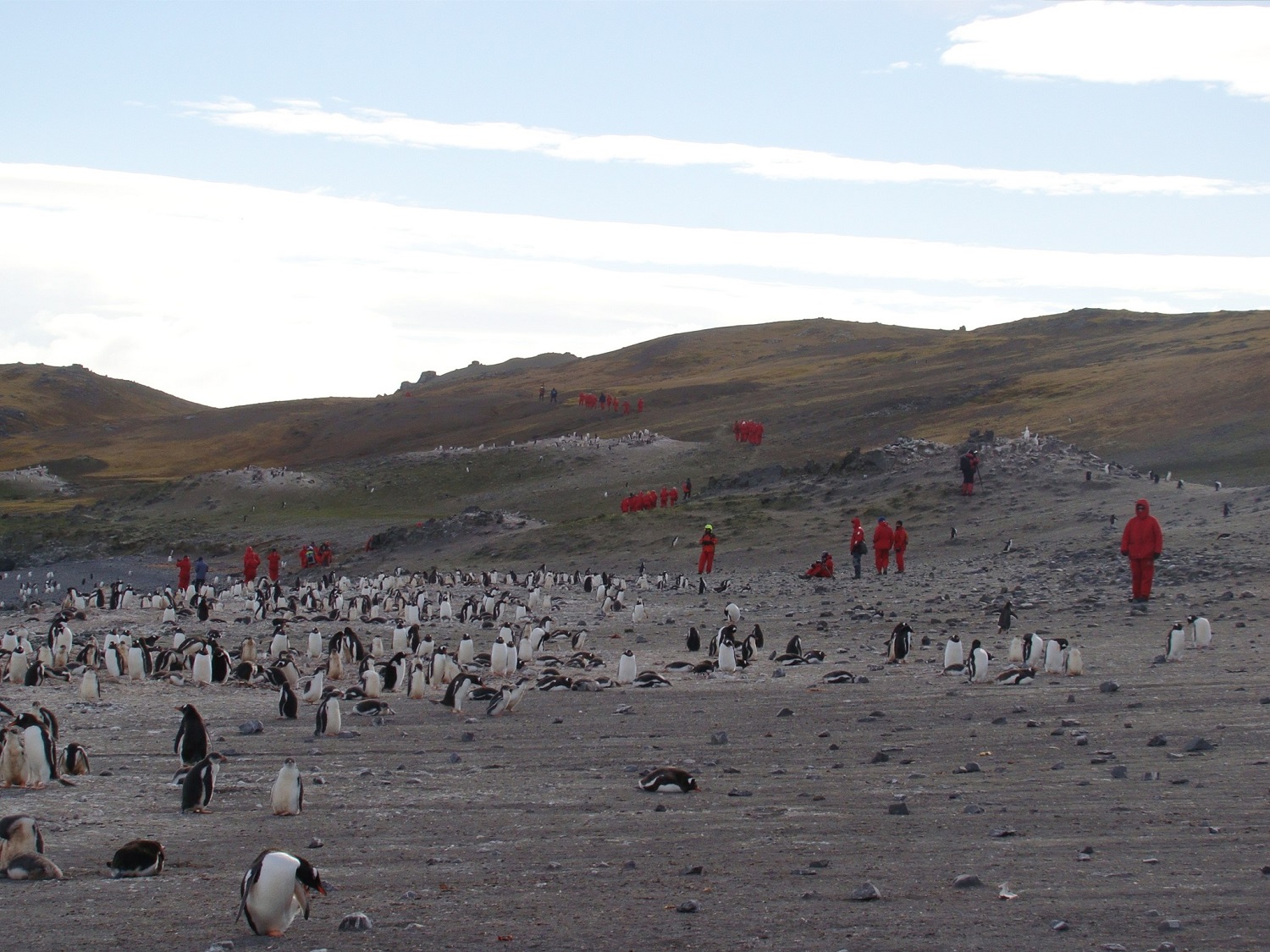
Tourists interacting with a Gentoo penguin (Pygoscelis papua) colony at a popular visitor site
Measures are therefore needed to better protect the environment of Antarctica from tourism , but there are gaps in existing governance frameworks.
All activities in Antarctica are regulated through the Antarctic Treaty System (ATS), which includes The Madrid Protocol. The Protocol provides broad rules for tourism, however day-to-day management is mostly self-regulated by the industry through guidance issued by the International Association of Antarctica Tour Operators (IAATO).
Many researchers and conservation organisations are concerned that self-regulation is no longer sufficient to protect Antarctica’s wildlife and ecosystems from the impacts of tourism.
Why is this important?
The protection of the Antarctic environment is vital to achieve global goals for nature, climate and sustainable development.
However, as the Antarctic tourism industry grows and diversifies, the severity of its negative environmental impacts is likely to increase . If left unchecked, these impacts will be exacerbated by the effects of climate change . For example, reduced sea ice and increased ice-free land areas mean that tourists can visit previously inaccessible places, and a warmer climate will allow the industry to extend the tourist season.
The negative impacts of tourism compound other threats to Antarctica’s wildlife and ecosystems , such as climate change and invasive alien species .
Combined, these threaten the continent’s unique biodiversity, including species such as krill, fish, seals, whales, penguins and other seabirds , as well as putting at risk Antarctica’s ability to help regulate the global climate.
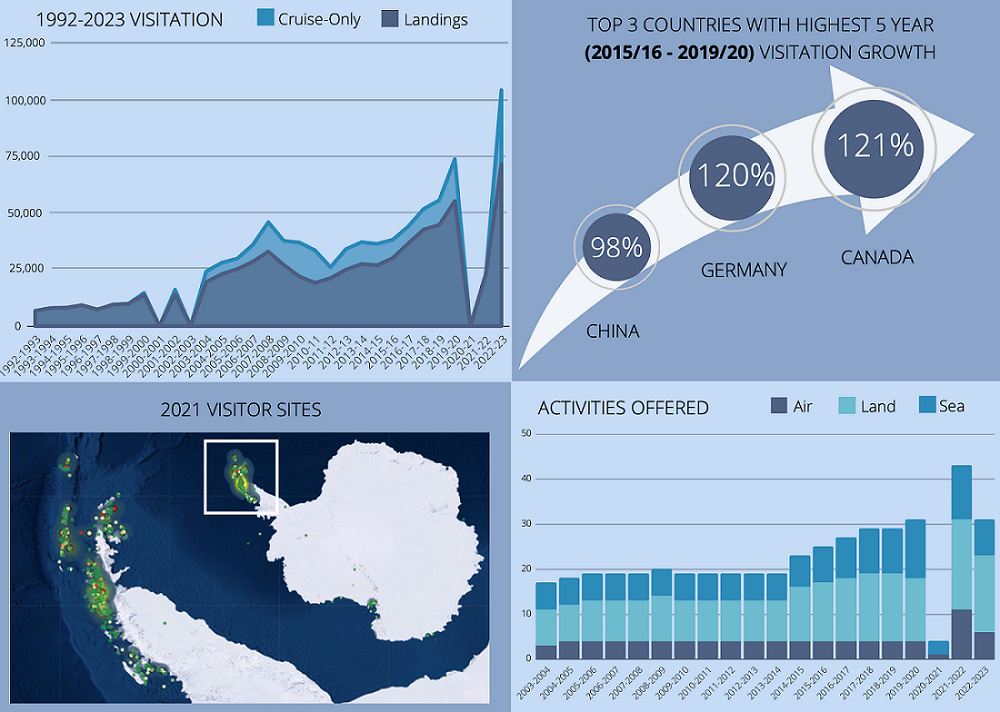
Visitor trends, fastest-growing source markets, distribution of visitor sites and growth in tourism activities
What can be done?
Tourism in Antarctica must be effectively and proactively managed, with decisions based on science and informed by best practice .
Such an approach should consider projections of tourism and climate trends, and will require the cooperation of stakeholders including the tourist industry (IAATO and its members), researchers, conservation organisations and governments (via national Antarctic programmes).
More research is needed to inform the policies and implementation of this management approach. All proposed visitor sites and tourist activities should be evaluated using the precautionary principle . Researchers should explore the ecological impacts of tourist activities at local and regional levels, assess existing guidelines and whether tourism operators comply with them, and identify the gaps in current protections.
It is likely new safeguards will be needed , which could include stronger protections within the Antarctic Treaty System or specifying the appropriate type, amount, location and route of tourism activities in the management plans for all Antarctic protected areas.
Continual monitoring of tourism impacts is essential to assess and refine the effectiveness of new protections. Governments, research funders and the tourism industry should support monitoring programmes and help coordinate research activities.
Researchers should develop indicators that go beyond counting visitor numbers , and reflect wider impacts on Antarctica’s biodiversity, wilderness and ecosystem services.
Efforts should be made to enhance the positive impacts of tourism as a conservation tool . Measures could include incorporating more conservation education into visitors’ schedules, and involving tourists in Antarctic citizen science programmes in which members of the public help gather data for research projects.
Researchers should also evaluate how visiting Antarctica changes tourists’ long-term behaviour.
Where can I get more information?
IUCN WCC 2016 Resolution 032 Achieving representative systems of protected areas in Antarctica and the Southern Ocean
Strategy for IUCN’s Programme and Policy on Antarctic Issues (IUCN, 2009)
A Strategy for Antarctic Conservation (IUCN, 1991)
Tourism and Non-governmental Activities (ATS, 2022)
Proactive Management of Antarctic Tourism: Time for a Fresh Approach. ATCM XLII, IP 26 (ATS, 2019)
Cajiao D, Benayas J, Tejedo P, Leung Y-F. Adaptive Management of Sustainable Tourism in Antarctica: A Rhetoric or Working Progress? Sustainability . 2021; 13(14):7649. doi.org/10.3390/su13147649
Related content

Brief for the UNFCCC SB60 Expert Dialogue on Mountains and Climate Change. This brief aims to…
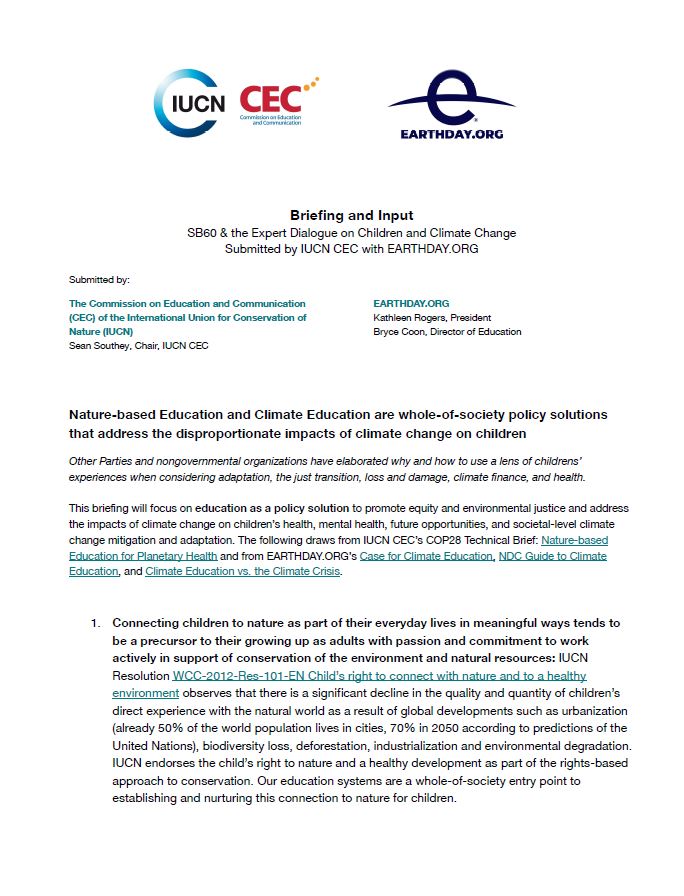
Briefing and input to the UNFCCC SB60 & the Expert Dialogue on children and climate change.…
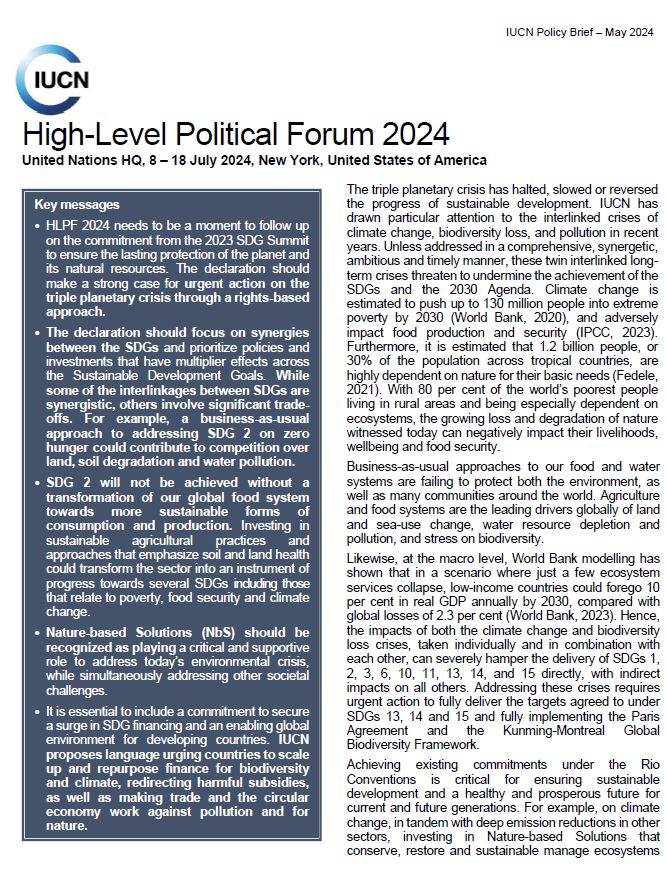
Sign up for an IUCN newsletter
An official website of the United States government
Here's how you know
Official websites use .gov A .gov website belongs to an official government organization in the United States.
Secure .gov websites use HTTPS. A lock ( Lock Locked padlock ) or https:// means you've safely connected to the .gov website. Share sensitive information only on official, secure websites.
Geosciences (GEO)
- Research Areas
- Geosciences
- Polar Programs
Antarctic Conservation Act and Permits
The Antarctic Conservation Act (ACA) , protects native mammals, birds, plants, and their ecosystems.
The law applies to:
- all U.S. citizens going to Antarctica, whether or not they go to Antarctica with the U.S. Antarctic Program
- all Antarctic expeditions that originate from the United States
Without a permit it is illegal to:
- take native mammals or birds
- engage in harmful interference
- enter Antarctic Specially Protected Areas (ASPAs)
- introduce species to Antarctica
- introduce substances designated as waste
- discharge designated waste
- import certain Antarctic items into the USA or export them to another country
For definitions of these activities, see subsections 670.3 and 671.3 of the ACA, Public Law 95-541 (as amended by Public Law 104-227) found here , or request a free paper copy (NSF 01-151) via the contact information at the bottom of this page.
Violations of the ACA can result in penalties of up to approximately $28,000 and 1-year imprisonment per violation, removal from Antarctica, cancellation of a grant, and/or sanctions by your employer.
- Download a PDF of the ACA Flora, Fauna, and Protected Area Permit Application Form .
- Fill it out either via software on your computer, or print a copy and then scan for email submission.
- Submit it to the ACA Permit Officer preferably by e-mail: [email protected] , or at the mailing address listed at the bottom of this page.
An up to date list of ASPAs and their management plans are posted on the Antarctic Treaty website. Note that the permit processing time is ~45-60 days . A summary of the application gets published in the Federal Register for a required 30-day public comment period. Public comments are evaluated, followed by an internal NSF review, and permits are then approved, approved with modifications, or denied.
Are you a non-grantee doing science? People not funded by NSF that need permits for valid scientific work should follow the process listed above.
Are you a non-grantee (tour or scientific group)? You may need to apply for an ACA Waste Permit. Please contact the ACA Permit Officer at [email protected] for further details.
Questions about the ACA or permits should be directed to the Permit Office: [email protected] , or see further contact information at the bottom of this page.
History The Antarctic Conservation Act incorporates into U.S. regulations the environmental standards set forth by the Protocol on Environmental Protection , which was developed by consensus by representatives of the U.S. and other Antarctic Treaty nations. The Protocol designates Antarctica as a natural reserve, devoted to peace and science (Article 2). The Antarctic Treaty and the Environmental Protocol form the basic guidelines for all human activity on the Antarctic continent and all Consultative Parties have laws in force in their respective home legislation to govern their citizens accordingly. For more information, see the website of the Secretariat of the Antarctic Treaty .
Contact information by mail or phone To contact the permit office: Permit Office Office of Polar Programs 2415 Eisenhower Avenue Suite W7100 Alexandria, VA 22331 Phone: 703-292-8030 -->
To request paper copies of documents (please reference the document code): NSF Publications National Science Foundation 2415 Eisenhower Avenue Alexandria, VA 22331 Online order form: https://www.nsf.gov/publications/orderpub.jsp Phone: 703-292-7827

India to host first-ever focused working group discussions on regulating tourism in Antarctica
New Delhi: The first-ever focused working group discussions on regulating tourism in Antarctica will be held in Kochi, Kerala on May 20-30, 2024. The meeting, to be organized by the Indian government along with the National Centre for Polar and Ocean Research (NCPOR) and the Antarctic Treaty Secretariat, will draw participation from over 350 people from nearly 40 countries, a PIB press release stated.
The discussions at the 46th Antarctic Treaty Consultative Meeting (ATCM) and 26 Meeting of the Committee for Environmental Protection (CEP) will focus on the regulation of tourism in a way that preserves the ecological integrity of Antarctica. The growing number of tourists visiting Antarctica every year is one of the major concerns as it has the potential to adversely impact the fragile environment of the region.
The government is committed to protecting the pristine environment of Antarctica and promoting sustainable tourism activities in the region. The country’s efforts in this regard include the Indian Antarctic Act, 2022, which aims to regulate tourism in accordance with international standards. The 46th ATCM will also provide an opportunity to discuss the induction of Canada and Belarus as consultative parties to the Antarctic Treaty System. Canada and Belarus have been signatories to the Antarctic Treaty System since 1988 and 2006, respectively. The inclusion of these two countries in the system will strengthen the cooperation in the exploration and conservation of Antarctica.
The government is also committed to promoting scientific research and environmental protection in Antarctica. A number of research stations have been set up and funds have been granted for various research projects. The government is also committed to enforcing environmental regulations and promoting sustainable tourism activities in the region. The 46th ATCM and 26 CEP will be a crucial platform for the governments and stakeholders to come together and discuss the future of tourism in Antarctica. The discussions will focus on the regulation of tourism in a way that preserves the ecological integrity of the region.

Advertisement
Supported by
Climate Change Added a Month’s Worth of Extra-Hot Days in Past Year
Since last May, the average person experienced 26 more days of abnormal warmth than they would have without global warming, a new analysis found.
- Share full article

By Raymond Zhong
Over the past year of record-shattering warmth, the average person on Earth experienced 26 more days of abnormally high temperatures than they otherwise would have, were it not for human-induced climate change, scientists said Tuesday.
The past 12 months have been the planet’s hottest ever measured, and the burning of fossil fuels, which has added huge amounts of heat-trapping gases to the atmosphere, is a major reason. Nearly 80 percent of the world’s population experienced at least 31 days of atypical warmth since last May as a result of human-caused warming, the researchers’ analysis found.
Hypothetically, had we not heated the globe to its current state , the number of unusually warm days would have been far fewer, the scientists estimated, using mathematical modeling of the global climate.
The precise difference varies place to place. In some countries, it is just two or three weeks, the researchers found. In others, including Colombia, Indonesia and Rwanda, the difference is upward of 120 days.
“That’s a lot of toll that we’ve imposed on people,” said one of the researchers who conducted the new analysis, Andrew Pershing, the vice president for science at Climate Central, a nonprofit research and news organization based in Princeton, N.J., adding, “It’s a lot of toll that we’ve imposed on nature.” In parts of South America and Africa, he said, it amounts to “120 days that just wouldn’t be there without climate change.”
Currently, the world’s climate is shifting toward the La Niña phase of the cyclical pattern known as the El Niño-Southern Oscillation. This typically portends cooler temperatures on average. Even so, the recent heat could have reverberating effects on weather and storms in some places for months to come. Forecasters expect this year’s Atlantic hurricane season to be extraordinarily active, in part because the ocean waters where storms form have been off-the-charts warm.
The analysis issued Tuesday was a collaboration between several groups: Climate Central, the Red Cross Red Crescent Climate Centre and World Weather Attribution, a scientific initiative that examines extreme weather episodes. The report’s authors considered a given day’s temperature to be abnormally high in a particular location if it exceeded 90 percent of the daily temperatures recorded there between 1991 and 2020.
The average American experienced 39 days of such temperatures as a result of climate change since last May, the report found. That’s 19 more days than in a hypothetical world without human-caused warming. In some states, including Arizona and New Mexico in the Southwest and Washington and Oregon in the Northwest, the difference is 30 days or more, a full extra month.
The scientists also tallied up how many extreme heat waves the planet had experienced since last May. They defined these as episodes of unseasonable warmth across a large area, lasting three or more days, with significant loss of life or disruption to infrastructure and industry.
In total, the researchers identified 76 such episodes over the past year, affecting 90 countries, on every continent except Antarctica. There was the punishing hot spell in India last spring. There was the extreme heat that worsened wildfires and strained power grids in North America, Europe and East Asia last summer. And, already this year, there has been excessive warmth from Africa to the Middle East to Southeast Asia .
Raymond Zhong reports on climate and environmental issues for The Times. More about Raymond Zhong
Our Coverage of Climate and the Environment
News and Analysis
Human-caused warming has doubled the chances that southern Brazil will experience extreme, multiday downpours like the ones that recently caused disastrous flooding there, a team of scientists said.
Over the past year of record-shattering warmth, the average person on Earth experienced 26 more days of abnormally high temperatures than they otherwise would have, were it not for human-induced climate change, scientists said.
The Biden administration laid out for the first time a set of broad government guidelines around the use of carbon offsets in an attempt to shore up confidence in a method for tackling global warming that has faced growing criticism.
Adopting Orphaned Oil Wells: Students, nonprofit groups and others are fund-raising to cap highly polluting oil and gas wells abandoned by industry.
Struggling N.Y.C. Neighborhoods: New data projects are linking social issues with global warming. Here’s what that means for five communities in New York .
Biden Environmental Rules: The Biden administration has rushed to finalize 10 major environmental regulations to meet its self-imposed spring deadline.
F.A.Q.: Have questions about climate change? We’ve got answers .

PEKIN, Elektrostal - Lenina Ave. 40/8 - Restaurant Reviews, Photos & Phone Number - Tripadvisor
Current time by city
For example, New York
Current time by country
For example, Japan
Time difference
For example, London
For example, Dubai
Coordinates
For example, Hong Kong
For example, Delhi
For example, Sydney
Geographic coordinates of Elektrostal, Moscow Oblast, Russia
City coordinates
Coordinates of Elektrostal in decimal degrees
Coordinates of elektrostal in degrees and decimal minutes, utm coordinates of elektrostal, geographic coordinate systems.
WGS 84 coordinate reference system is the latest revision of the World Geodetic System, which is used in mapping and navigation, including GPS satellite navigation system (the Global Positioning System).
Geographic coordinates (latitude and longitude) define a position on the Earth’s surface. Coordinates are angular units. The canonical form of latitude and longitude representation uses degrees (°), minutes (′), and seconds (″). GPS systems widely use coordinates in degrees and decimal minutes, or in decimal degrees.
Latitude varies from −90° to 90°. The latitude of the Equator is 0°; the latitude of the South Pole is −90°; the latitude of the North Pole is 90°. Positive latitude values correspond to the geographic locations north of the Equator (abbrev. N). Negative latitude values correspond to the geographic locations south of the Equator (abbrev. S).
Longitude is counted from the prime meridian ( IERS Reference Meridian for WGS 84) and varies from −180° to 180°. Positive longitude values correspond to the geographic locations east of the prime meridian (abbrev. E). Negative longitude values correspond to the geographic locations west of the prime meridian (abbrev. W).
UTM or Universal Transverse Mercator coordinate system divides the Earth’s surface into 60 longitudinal zones. The coordinates of a location within each zone are defined as a planar coordinate pair related to the intersection of the equator and the zone’s central meridian, and measured in meters.
Elevation above sea level is a measure of a geographic location’s height. We are using the global digital elevation model GTOPO30 .
Elektrostal , Moscow Oblast, Russia

IMAGES
VIDEO
COMMENTS
The main ATCM regulations and guidelines for tourists and expedition organizers are compiled in the Manual of Regulations and Guidelines Relevant to Tourism and Non-Governmental Activities in the Antarctic Treaty area, adopted by ATCM XLIII through Decision 6 (2021). This compilation also includes the provisions applicable to tourism arising ...
I. Developments in Antarctic Tourism Antarctic tourism started in the 1960s and until the mid-1980s the average numbers remained below one thousand tourists per season. Footnote 1 Since the adoption of the Protocol on Environmental Protection to the Antarctic Treaty (Protocol) Footnote 2 in 1991, the number of tourists visiting Antarctica Footnote 3 has increased from almost 6,500 in the 1991 ...
In the years 2022 to 2023, there were even just under 105,000 tourists. Claire Christian, head of the Antarctic and Southern Ocean Coalition ASOC, the only non-governmental organization allowed to attend the meeting, says: " Formal regulation of tourism has been delayed for too long. However, the upcoming ATCM offers a crucial opportunity to ...
Abstract. Antarctic tourism has experienced a boom period over the last thirty years. Beginning in the 1980s, the number of tourists who visited the continent annually began to rise sharply, and within the space of twenty years the numbers had increased by more than six hundred percent. Despite a global recession and downturn in visitor numbers ...
3. Tourism Trends and Environmental Pressures. Tourism is growing and diversifying rapidly, becoming established in new destination sites, using new modes of transportation, and resulting in increased traffic. Protecting the Antarctic environment means ensuring that tourism developments takes place according to clear rules.
The most important instrument regulating tourism in Antarctica is the Protocol on Environmental Protection to the Antarctic Treaty in 1991 (Protocol 1991), which entered into force on 15 January 1998.This Protocol establishes a comprehensive system of obligations and prohibitions, addressing most human activities, including all types of tourism activities, in the region south of 60° south ...
The article covers two cutting-edge issues in current Antarctic affairs: the challenges associated with consensus-based decision-making (which hold back progress on environmental protection and other matters) and the difficulties with moving forward on regulation of Antarctic tourism. Although the article focuses on actions taken by States ...
Tourism has become pervasive in and around the continent - particularly on the Antarctic Peninsula - yet affecting the geographies and place-making of Antarctica as a whole. Nevertheless, as analyzed by Stewart et al. ( 2017 ), tourism studies of Antarctica have targeted the industry's development and management perspectives.
In this light, options are identified for strengthening Antarctic decision-making regarding Antarctic tourism. AB - In the 2022-2023 season, more than 104,000 tourists visited Antarctica. This represents an increase of more than 40 percent compared to the 2019-20 pre-pandemic season.
With the wind-down of COVID-19 restrictions, travel has surged, including to exotic places like Antarctica. More than 100,000 people are expected to visit the southernmost continent this season.
The Antarctic Conservation Act (ACA), as amended, applies to, among others, tour operators and tourists subject to the jurisdiction of the United States. Under the ACA, it is unlawful, unless authorized by permit, for tourist expeditions and others subject to U.S. jurisdiction to: Import certain Antarctic items into the United States.
Methods. A content analysis of policy documents was conducted to determine how Antarctic tourism diversification has been discussed. This method allows for systematic organisation and pattern finding, Footnote 61 similarly employed in past tourism studies, for instance, to track the evolution of sustainable tourism discourse in policy documents Footnote 62 or to understand policy development ...
Antarctic tourism is mainly ship-based and managed on a day-to-day basis by the industry using guidelines for behaviour designed specifically for tourist sites. Regulation comes mainly from international shipping law. There are increasing concerns about climate change, shipping accidents and growing tourist numbers, prompting calls for stricter ...
During the early 1990s, debate on the adequacy of the regulation of tourism in Antarctica provided one of the more vigorous exchanges between Antarctic Treaty parties. Coming so soon after the adoption of the Environmental Protocol,1the debate may have fuelled doubts...
Tourism started in Antarctica by the sea in the 1960s. Air overflights started in the 1970s with sightseeing flights by airliners from Australia and New Zealand, and were resumed in the 1990s. The (summer) tour season lasts from November to March. Most of the estimated 14,762 visitors to Antarctica from 1999-2000 were on sea cruises. [1]
Between 1992 and 2020 the number of tourists visiting Antarctica increased ten-fold and continues to grow, meaning the negative environmental impacts of tourism are likely to increase. Existing regulations do not adequately protect the environment of Antarctica from tourism impacts, which include damage at visitor sites and along travel routes, and the disturbance of wildlife.
In the 2022-2023 season, more than 104,000 tourists visited Antarctica. This represents an increase of more than 40 percent compared to the 2019-2020 pre-pandemic season.
Antarctic Tourism and the Precautionary Principle, 50 Int'l & Comp. L.Q. 963 (2001)Google Scholar (discussing the different approaches of the ATS members to managing mining and managing tourism and concluding: "Tourism is covered by only a very weak application of the precautionary principle while the application of the precautionary ...
The Antarctic Conservation Act (ACA), protects native mammals, birds, plants, and their ecosystems. The law applies to: Without a permit it is illegal to: For definitions of these activities, see subsections 670.3 and 671.3 of the ACA, Public Law 95-541 (as amended by Public Law 104-227) found here, or request a free paper copy (NSF 01-151) via ...
The discussions at the 46th Antarctic Treaty Consultative Meeting (ATCM) and 26 Meeting of the Committee for Environmental Protection (CEP) will focus on the regulation of tourism in a way that ...
In total, the researchers identified 76 such episodes over the past year, affecting 90 countries, on every continent except Antarctica. There was the punishing hot spell in India last spring.
17 reviews. #12 of 28 Restaurants in Elektrostal $$ - $$$, Asian. Lenina Ave., 40/8, Elektrostal 144005 Russia. +7 495 120-35-45 + Add website + Add hours Improve this listing. See all (5)
Moscow Oblast ( Russian: Моско́вская о́бласть, Moskovskaya oblast) is a federal subject of Russia. It is located in western Russia, and it completely surrounds Moscow. The oblast has no capital, and oblast officials reside in Moscow or in other cities within the oblast. [1] As of 2015, the oblast has a population of 7,231,068 ...
You are free: to share - to copy, distribute and transmit the work; to remix - to adapt the work; Under the following conditions: attribution - You must give appropriate credit, provide a link to the license, and indicate if changes were made. You may do so in any reasonable manner, but not in any way that suggests the licensor endorses you or your use.
Find out the distance between Elektrostal and the North Pole, the South Pole, the Equator, the Tropic of Cancer, the Tropic of Capricorn, the Arctic Circle, the Antarctic Circle Freemeteo.com: Elektrostal's weather Wikipedia article: Elektrostal See the monthly sunrise and sunset table for Elektrostal